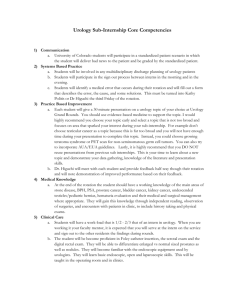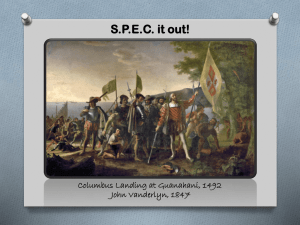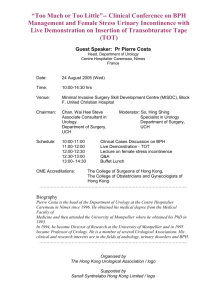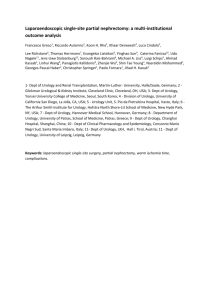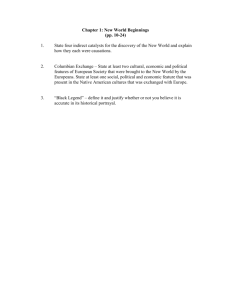George Washington University Medical Center Landmarks in the
advertisement
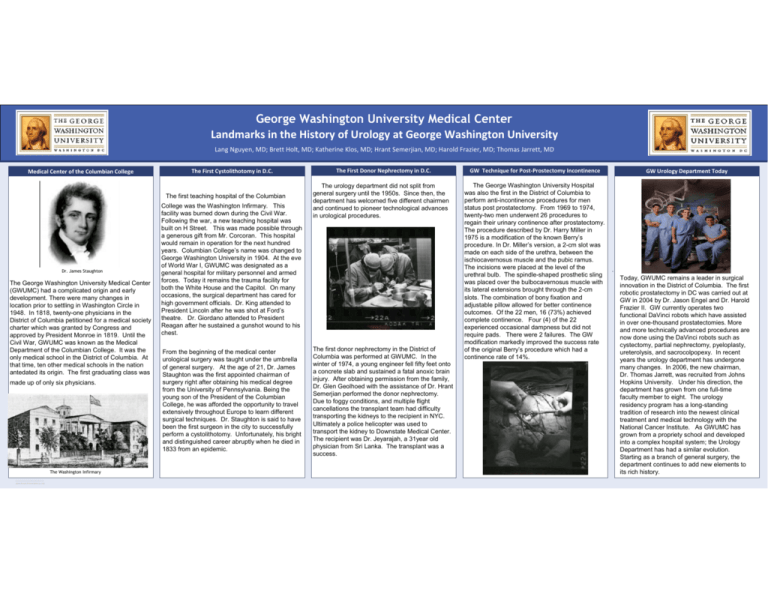
George Washington University Medical Center Landmarks in the History of Urology at George Washington University Lang Nguyen, MD; Brett Holt, MD; Katherine Klos, MD; Hrant Semerjian, MD; Harold Frazier, MD; Thomas Jarrett, MD Medical Center of the Columbian College The First Cystolithotomy in D.C. The first teaching hospital of the Columbian Dr. James Staughton The George Washington University Medical Center (GWUMC) had a complicated origin and early development. There were many changes in location prior to settling in Washington Circle in 1948. In 1818, twenty-one physicians in the District of Columbia petitioned for a medical society charter which was granted by Congress and approved by President Monroe in 1819. Until the Civil War, GWUMC was known as the Medical Department of the Columbian College. It was the only medical school in the District of Columbia. At that time, ten other medical schools in the nation antedated its origin. The first graduating class was made up of only six physicians. The Washington Infirmary RESEARCH POSTER PRESENTATION DESIGN © 2011 www.PosterPresentations.com College was the Washington Infirmary. This facility was burned down during the Civil War. Following the war, a new teaching hospital was built on H Street. This was made possible through a generous gift from Mr. Corcoran. This hospital would remain in operation for the next hundred years. Columbian College’s name was changed to George Washington University in 1904. At the eve of World War I, GWUMC was designated as a general hospital for military personnel and armed forces. Today it remains the trauma facility for both the White House and the Capitol. On many occasions, the surgical department has cared for high government officials. Dr. King attended to President Lincoln after he was shot at Ford’s theatre. Dr. Giordano attended to President Reagan after he sustained a gunshot wound to his chest. From the beginning of the medical center urological surgery was taught under the umbrella of general surgery. At the age of 21, Dr. James Staughton was the first appointed chairman of surgery right after obtaining his medical degree from the University of Pennsylvania. Being the young son of the President of the Columbian College, he was afforded the opportunity to travel extensively throughout Europe to learn different surgical techniques. Dr. Staughton is said to have been the first surgeon in the city to successfully perform a cystolithotomy. Unfortunately, his bright and distinguished career abruptly when he died in 1833 from an epidemic. The First Donor Nephrectomy in D.C. The urology department did not split from general surgery until the 1950s. Since then, the department has welcomed five different chairmen and continued to pioneer technological advances in urological procedures. The first donor nephrectomy in the District of Columbia was performed at GWUMC. In the winter of 1974, a young engineer fell fifty feet onto a concrete slab and sustained a fatal anoxic brain injury. After obtaining permission from the family, Dr. Glen Geolhoed with the assistance of Dr. Hrant Semerjian performed the donor nephrectomy. Due to foggy conditions, and multiple flight cancellations the transplant team had difficulty transporting the kidneys to the recipient in NYC. Ultimately a police helicopter was used to transport the kidney to Downstate Medical Center. The recipient was Dr. Jeyarajah, a 31year old physician from Sri Lanka. The transplant was a success. GW Technique for Post‐Prostectomy Incontinence The George Washington University Hospital was also the first in the District of Columbia to perform anti-incontinence procedures for men status post prostatectomy. From 1969 to 1974, twenty-two men underwent 26 procedures to regain their urinary continence after prostatectomy. The procedure described by Dr. Harry Miller in 1975 is a modification of the known Berry’s procedure. In Dr. Miller’s version, a 2-cm slot was made on each side of the urethra, between the ischiocavernosus muscle and the pubic ramus. The incisions were placed at the level of the urethral bulb. The spindle-shaped prosthetic sling was placed over the bulbocavernosus muscle with its lateral extensions brought through the 2-cm slots. The combination of bony fixation and adjustable pillow allowed for better continence outcomes. Of the 22 men, 16 (73%) achieved complete continence. Four (4) of the 22 experienced occasional dampness but did not require pads. There were 2 failures. The GW modification markedly improved the success rate of the original Berry’s procedure which had a continence rate of 14%. GW Urology Department Today . Today, GWUMC remains a leader in surgical innovation in the District of Columbia. The first robotic prostatectomy in DC was carried out at GW in 2004 by Dr. Jason Engel and Dr. Harold Frazier II. GW currently operates two functional DaVinci robots which have assisted in over one-thousand prostatectomies. More and more technically advanced procedures are now done using the DaVinci robots such as cystectomy, partial nephrectomy, pyeloplasty, ureterolysis, and sacrocolpopexy. In recent years the urology department has undergone many changes. In 2006, the new chairman, Dr. Thomas Jarrett, was recruited from Johns Hopkins University. Under his direction, the department has grown from one full-time faculty member to eight. The urology residency program has a long-standing tradition of research into the newest clinical treatment and medical technology with the National Cancer Institute. As GWUMC has grown from a propriety school and developed into a complex hospital system; the Urology Department has had a similar evolution. Starting as a branch of general surgery, the department continues to add new elements to its rich history.

